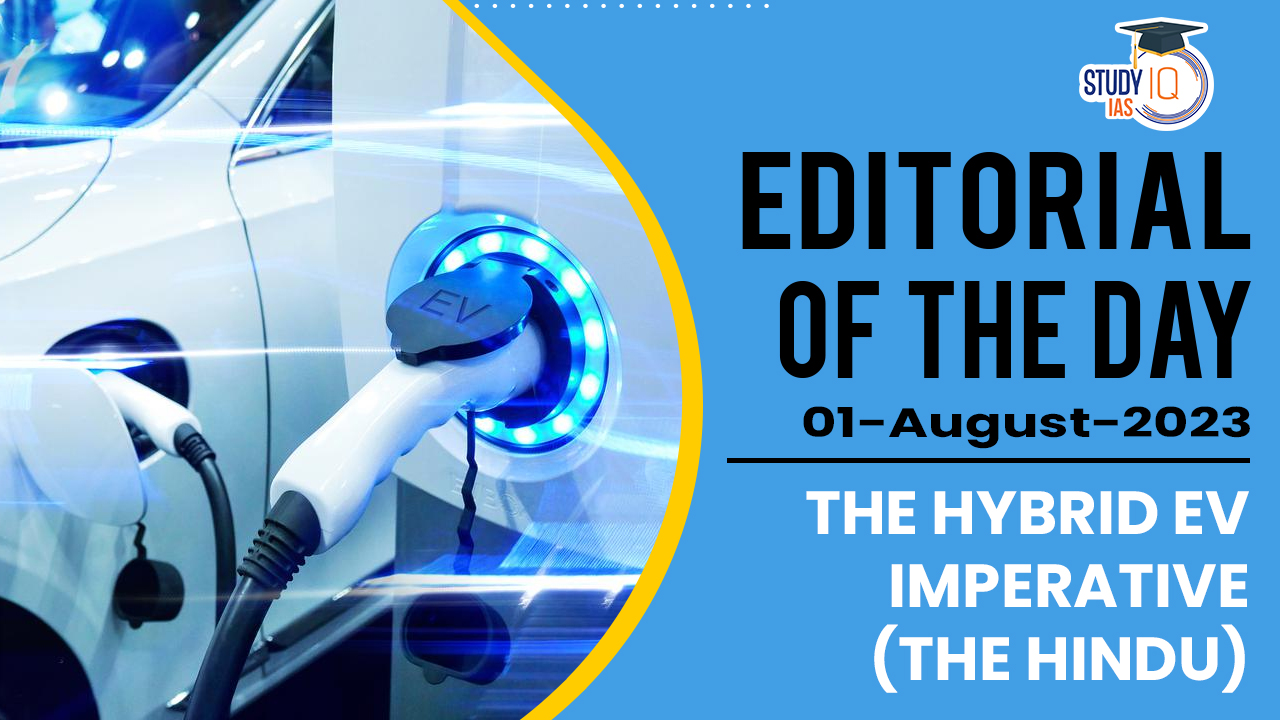Context: The article is discussing the importance of hybrid electric vehicles (HEVs) in the world’s transition to a net-zero future, especially in economically developing countries. It emphasizes that while the power generation and grid capacity in these countries may not be ready for a large-scale adoption of fully electric vehicles (EVs), hybrid EVs present a significant opportunity to start the shift towards sustainable transportation immediately. Overall, the article signifies how hybrid EVs are a crucial element in the global effort to achieve a net-zero future by providing a bridge between conventional internal combustion engine vehicles and fully electric vehicles.
Decoding the Editorial
The article suggests that in countries where power generation relies heavily on fossil fuels and the fraction of renewable sources in the power generation mix is low, it can be challenging to support a large fleet of EVs due to grid limitations and the lack of fast-charging infrastructure. In such cases, adopting hybrid EVs can be a practical and viable way to begin the transition towards net-zero emissions, without waiting for full EV adoption.
Hybrid EVs:
- HEVs combine both internal combustion engines and electric drivetrains, which results in higher fuel economy and reduced carbon emissions compared to traditional gasoline-powered vehicles.
- This makes them an effective short-term solution to lower emissions and fuel costs while paving the way for a more sustainable future.
- They offer economically developing countries an opportunity to kickstart the shift towards sustainable transportation while addressing infrastructure and cost challenges associated with a complete transition to EVs.
The article also discusses the following terms and dimensions:
What is net-zero for a vehicle?
- Net-zero for a vehicle includes emissions at both the tailpipe of the vehicle and at the power plant.
- Making vehicles net-zero requires cutting emissions from both new and existing vehicles.
Types of Electric Vehicles (EVs):
- Hybrid Electric Vehicle (HEV):
- A hybrid EV is a vehicle that is propelled by an electric drivetrain, but it also has an internal combustion engine (ICE) that acts as a generator to produce electricity.
- The electricity generated is used to charge a small battery, typically 1-5 kWh, which serves as an energy buffer to store the electricity.
- The vehicle’s propulsion can be provided by the electric motor, the ICE, or a combination of both.
- Full Electric Vehicle (FEV):
- A full EV, also known as a battery EV or a plug-in EV, relies entirely on its electric drivetrain and does not have an internal combustion engine.
- This type of EV has a larger battery, typically ranging from 20 to 120 kWh, which stores electricity for powering the vehicle.
- It can only be charged from the electric grid and produces no tailpipe emissions since it lacks an ICE.
- Plug-in Hybrid Electric Vehicle (PHEV):
- A plug-in hybrid EV is essentially a hybrid EV with a larger battery, typically ranging from 5 to 15 kWh.
- This larger battery can be charged from the electric grid, allowing the vehicle to operate in an all-electric mode as long as there is energy stored in the battery.
- When the battery depletes, the vehicle can switch to using its internal combustion engine or a combination of the ICE and electric motor for propulsion.
- Fuel Cell Electric Vehicle (FCEV):
- A fuel-cell EV utilises a fuel cell to produce electricity for its electric drivetrain.
- The fuel cell combines hydrogen and oxygen to generate electricity, and a small battery buffer is used to manage variations in power demand.
- FCEVs produce no tailpipe emissions as the only byproduct of the fuel cell’s operation is water vapour.
- Fuel economy of hybrid and fully electric EVs:
- Hybrid EVs’ Fuel Economy: Hybrid Electric Vehicles (HEVs) exhibit better fuel economy compared to conventional Internal Combustion Engine (ICE) vehicles, especially in city driving conditions. The fuel economy of HEVs can be 1.5-2 times higher in city driving and 1-1.5 times higher in highway driving compared to conventional ICE vehicles. This improved fuel economy is attributed to the combination of an internal combustion engine, generator, and battery in HEVs, allowing for more efficient use of energy and reduced fuel consumption.
- Plug-in Hybrid EVs’ Fuel Economy: Plug-in Hybrid Electric Vehicles (PHEVs) offer even higher fuel economy benefits. They can cover 80-90% of short, day-to-day commutes in fully electric mode, with a larger battery (5-15 kWh) that can be charged from the electric grid. This enables PHEVs to achieve 3-4 times higher fuel economy than conventional vehicles during these short commutes. However, PHEVs can switch to the hybrid mode (using the internal combustion engine) for intercity trips or longer distances.
- Net emissions of hybrid EVs:
- Importance of Net Emissions: The article highlights that besides fuel economy, an essential metric for evaluating the environmental impact of vehicles is net emissions.
- Net emissions take into account both tailpipe emissions and emissions from fuel production (electricity or fossil fuels) throughout the vehicle’s life cycle.
- It includes emissions from vehicle and battery production, maintenance, and end-of-life recycling, providing a more comprehensive assessment of the vehicle’s environmental footprint.
- Impact of Power Production on EV Emissions:
- The grids of different countries vary in their degree of decarbonization. In the case of fully electric vehicles (FEVs), the emissions from power production significantly influence the vehicle’s overall well-to-wheel and life-cycle emissions.
- Lower emissions from power production (e.g., from renewable energy sources) result in lower overall emissions for FEVs, further supporting the importance of transitioning to cleaner power generation methods.
- Importance of Net Emissions: The article highlights that besides fuel economy, an essential metric for evaluating the environmental impact of vehicles is net emissions.
- How can hybrid or plug-in hybrid EVs help us decarbonise?
-
- Lower Emissions: Hybrid and plug-in hybrid EVs have lower emissions compared to conventional internal combustion engine (ICE) vehicles. Their ability to operate in electric mode during short trips or in urban areas, where emissions are a major concern, reduces the overall greenhouse gas emissions and air pollutants.
- Fuel Economy: Hybrid and plug-in hybrid EVs offer improved fuel economy, especially in stop-and-go city driving conditions. The use of electric power for propulsion and regenerative braking helps optimize energy use and reduce fuel consumption.
- Reduced Oil Dependence: Hybrid and plug-in hybrid EVs rely on electricity and have the option to operate without using gasoline for shorter distances. This reduces the overall consumption of fossil fuels and helps decrease dependence on oil imports.
- Transitioning Step: Hybrid and plug-in hybrid EVs serve as an important transitional step towards a future of full electric vehicles powered by renewable energy sources. They provide a more immediate solution to reduce emissions while the infrastructure and technology for full EVs continue to develop.
- Flexibility: Plug-in hybrid EVs offer the flexibility of operating in electric mode for short distances and switching to hybrid mode for longer trips, addressing the range limitations associated with full EVs. This makes them suitable for a wider range of use cases, such as in areas where charging infrastructure is still developing or for certain commercial applications like taxis.
- Regenerative Braking and Engine Start-Stop: Hybrid EVs’ regenerative braking system allows them to capture and reuse energy that would otherwise be lost as heat during braking. This improves fuel economy, especially in urban driving with frequent stop-and-go conditions. Additionally, the engine start-stop mechanism saves fuel by automatically shutting off the engine at traffic junctions and in heavy traffic.
- Price and Market Penetration: Hybrid vehicles are often priced only slightly higher than their conventional counterparts, making them more accessible to consumers. This affordability factor can encourage more people to adopt greener transportation options and contribute to decarbonization efforts.
Challenges to transitioning to electric mobility:
- Fast-Charging Infrastructure:
- Establishing a comprehensive and efficient fast-charging infrastructure is vital for the successful adoption of full electric vehicles (EVs).
- Fast-charging along highways is crucial to address range anxiety, as people desire affordable EVs that can serve both short and long-distance travel needs over many years.
- Fast-charging involves high-power levels ranging from 50-350 kW for cars and up to 1,000 kW for heavy-duty vehicles.
- However, the high capital cost of fast-chargers, the need for high-capacity power connections, and other factors contribute to wide variation in installation costs, making it a challenging aspect of the transition.
- Grid Access and Reliability:
- In many parts of the world, especially economically developing nations, access to a reliable electric grid is not universal.
- This lack of grid access, as well as grid reliability issues, can hinder the widespread adoption of EVs.
- The relatively high charging power requirements for both slow-charging (<22 kW) and fast-charging (<350 kW) can exacerbate the challenge in areas with limited generation and transmission capacities.
- Affordability and Battery Costs:
-
- EVs with longer ranges (300-400 km) often reach price parity with conventional vehicles in the richest countries at prices between $25,000-35,000 in the short term.
- However, high battery costs, which can range between $130-200 per kilowatt-hour at the pack level, contribute to the higher prices of EVs with larger battery packs needed for longer ranges.
- This affordability issue can pose a challenge for consumers in economically developing countries who may find it difficult to afford EVs with extended driving ranges.
Overcoming these challenges requires concerted efforts from various stakeholders, including governments, private companies, and international organizations. Addressing the fast-charging infrastructure, expanding access to reliable grids, and promoting research and development to reduce battery costs are crucial steps towards enabling a successful transition to electric mobility worldwide. Additionally, supportive policies, incentives, and public awareness campaigns can further facilitate the adoption of EVs and accelerate the shift towards a more sustainable and eco-friendly transportation system.


 Daily Quiz 16 July 2025
Daily Quiz 16 July 2025
 US Approach to the Trade Deal with India...
US Approach to the Trade Deal with India...





















